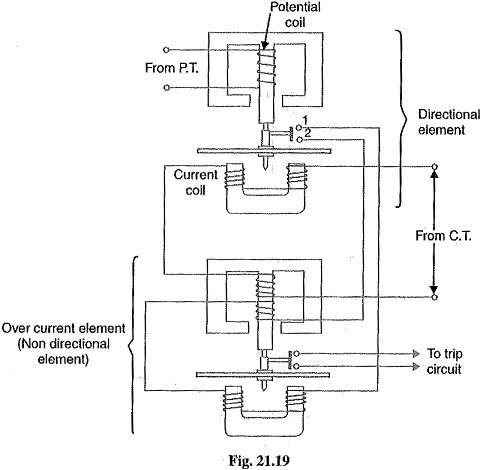Induction Type Directional Overcurrent Relay:
The directional power relay is unsuitable for use as a directional protective relay under short-circuit conditions. When a short-circuit occurs, the system voltage falls to a low value and there may be insufficient torque developed in the relay to cause its operation. This difficulty is overcome in the Induction Type Directional Overcurrent Relay which is designed to be almost independent of system voltage and power factor
Constructional details: Fig. 21.19 shows the constructional details of a typical Induction Type Directional Overcurrent Relay. It consists of two relay elements mounted on a common case viz.
- Directional element and
- Non-directional element.
1. Directional element: It is essentially a directional power relay which operates when power flows in a specific direction. The potential coil of this element is connected through a potential transformer (P.T.) to the system voltage. The current coil of the element is energised through a C.T. by the circuit current. This winding is carried over the upper magnet of the non-directional element. The trip contacts (1 and 2) of the directional element are connected in series with the secondary circuit of the overcurrent element. Therefore, the latter element cannot start to operate until its secondary circuit is completed. In other words, the directional element must operate first (i.e. contacts I and 2 should close) in order to operate the overcurrent element.
2. Non-directional element: It is an overcurrent element similar in all respects to a non-directional overcurrent relay described in Art. 21.11. The spindle of the disc of this element carries a moving contact which closes the fixed contacts (trip circuit contacts) after the operation of directional element.
It may be noted that plug-setting bridge is also provided in the relay for current setting but has been omitted in the figure for clarity and simplicity. The tappings are provided on the upper magnet of overcurrent element and are connected to the bridge.
Operation: Under normal operating conditions, power flows in the normal direction in the circuit protected by the relay. Therefore, Induction Type Directional Overcurrent Relay (upper element) does not operate, thereby keeping the overcurrent element (lower element) unenergised. However, when a short-circuit occurs, there is a tendency for the current or power to flow in the reverse direction. Should this happen, the disc of the upper element rotates to bridge the fixed contacts 1 and 2. This completes the circuit for overcurrent element.
The disc of this element rotates and the moving contact attached to it closes the trip circuit. This operates the circuit breaker which isolates the faulty section. The two relay elements are so arranged that final tripping of the current controlled by them is not made till the following conditions are satisfied :
- current flows in a direction such as to operate the directional element.
- current in the reverse direction exceeds the pre-set value.
- excessive current persists for a period corresponding to the time setting of overcurrent element.
